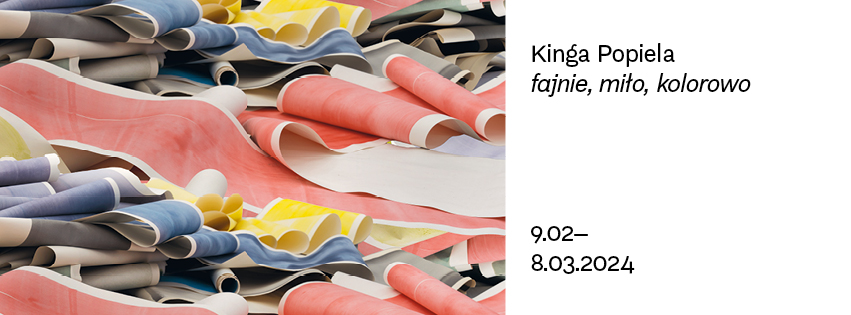
Kinga Popiela fun, nice, colorful
Exhibition duration Feb 9 – Mar 8 2024
The image of the perceived world that exists inside the mind is significantly different from the simple projection that occurs on the inner membrane of the retina. The eye removed from the skull, due to its physical structure, allows light rays to enter the eye and, like a cinema projector, creates an image on its back wall. It turns out, however, that the elements that the eye’s owner sees may change depending on the accumulated knowledge and acquired competences. Two people viewing the same frame or fragment of reality will read and understand it in a different way. This may involve both visual recognition and emotional feeling. Seeing does not always have to equal understanding, but it is always related to feeling and experiencing what is seen.
When we look, we fall into a network of indirect, camouflaged messages that, by affecting the body, also affect the recipient – we experience a visual encounter. Consequently, the reaction to a painting or work of art may be exactly the same as the reaction to a real event: it may cause tears, laughter or anger. The member of the audience is in a winning position: he looks at the object and, depending on his will, receives the information package in the way he chooses. It is the viewer who becomes the creator here – homo faber – who manages the moment of cognition, opens or closes himself to the visual message, surrendering to the game with the work and himself, allowing himself to experience the moment in the best way possible.
If we focus our attention on noticing color, we will notice certain intangible, yet expressive feelings. The sensations that emerge are often physical in nature because our eyes, while examining the obvious charm of color, also register its haptic properties. Thus, apart from visual experiences, we can also feel much more complex and physical impressions. Deep joy and satisfaction, sometimes stinging of the eyes, reminiscent of teasing the palate with a spicy sauce, and sometimes relief or sharp cold, as if we had touched a piece of ice. The color may look rough, prickly, slippery, it may encourage you to touch or stroke it, or it may repel, repulse, or irritate you. Even superficial color impressions can become a strong, internal emotion which, when properly fueled, can reach the deepest layers and recesses of the individual.
What do you feel when you look?
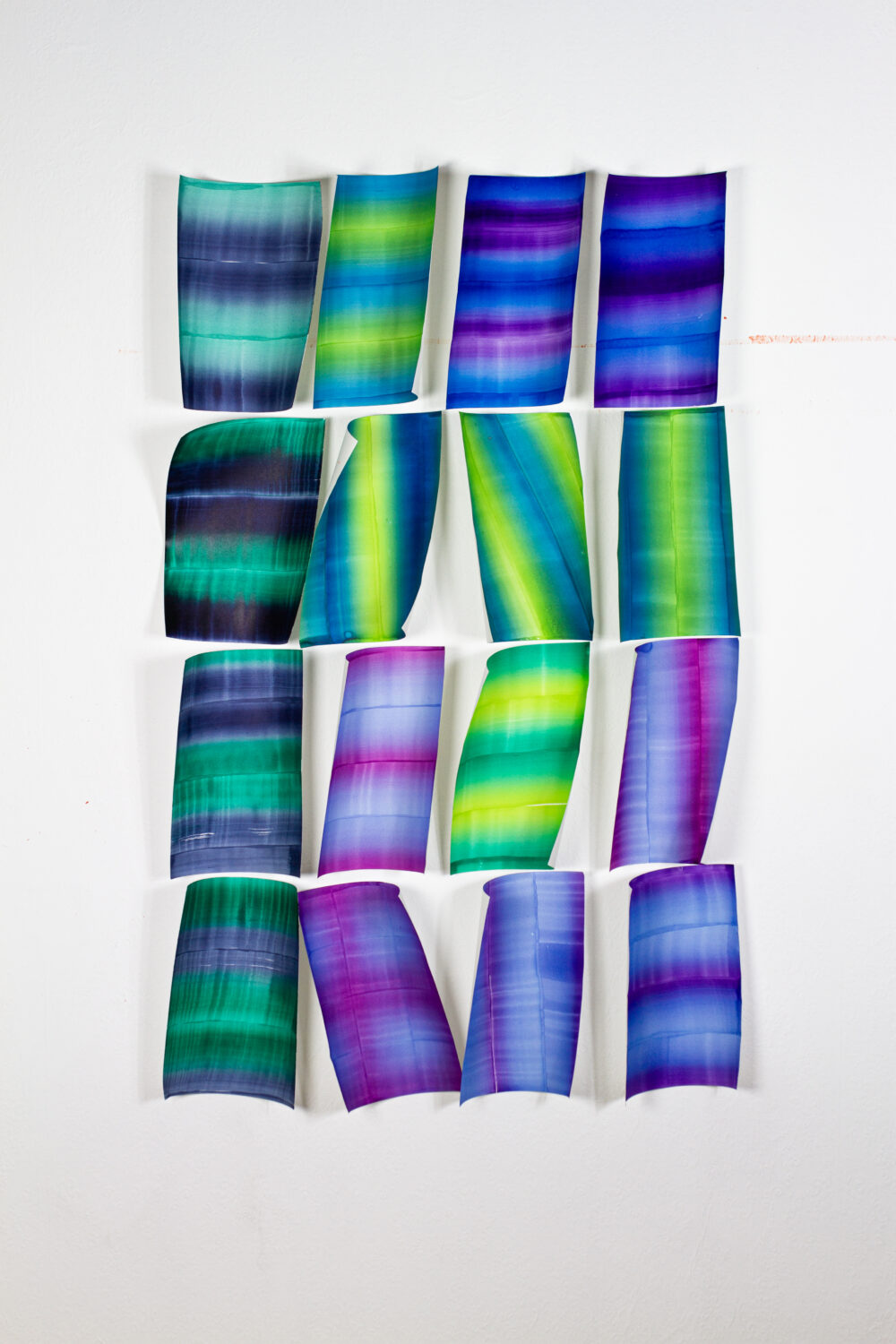
Because contact with art can simply be fun, nice and colorful.
French art historian and critic Eric de Chassey defines abstraction as a manner or method rather than a style or gesture. His approach is quoted by Christine Macel in the text “She Makes Abstraction” in the catalog for the exhibition “Women in Abstraction” from 2021(1). In the same text, the author also refers to the words of the philosopher and art historian Georges Roque, who understands abstraction as a form of language based on visual symbols.
These ways of understanding and seeing abstraction can be translated into the attitudes of creators who consciously use this medium. It is a conscious choice that involves an idea, the discovery of a method of creation, which also means consistency in the undertaken actions. I am not sure whether abstraction can be practiced between, in addition, or during a break between other artistic activities. I have the impression that it is an activity that is done fully, by giving it one’s all. It becomes an attitude that is reached in various ways, or that is deliberately adopted from the beginning. This is how I perceive Kinga Popiela’s work and approach to abstraction.
I first encountered her practice as part of the exhibition “From ‘abstraction’ to abstraction” organized in the spaces of the Stefan Gierowski Foundation in Warsaw in 2022. The artist presented works from the “Hylemorphism” series, which resembled waving organic structures. It is as if she was delving into a world invisible to the naked eye, accessible only with special devices. Contact with it, although real, seems unreal. The surfaces created by the artist were captivating not only with the intensity of colors but also with the rhythm of structures that had their own logic and were not accidental.
In the catalog accompanying the exhibition, the artist defines what abstraction means to her. Starting from post-humanist philosophy, which abolishes the division between what is human and non-human, animate and inanimate, the artist defines an abstract image as a causative entity, actively influencing the environment, which derives from reality and becomes its element (2).
In Kinga Popiela’s attitude shown in the “Hylemorphism” series, I see a continuation of the thinking and approach that inspired Jadwiga Maziarska (1913-2003). Since the 1980s, this painter has been fascinated by discoveries from the world of science, in particular molecular biology, which focused on reading the DNA code. Chains, connections, lines, particles, structures, sequences, rhythm, divisions and dependencies: the world of biology seems to penetrate Maziarska’s paintings, who in a conversation with Krystyna Czerni described herself as a realist and scientist (3). “There are no direct reflections of real structures in my paintings. The structures in my works differ from real ones because they were created by different conditions. An artist should not duplicate patterns from the outside world, but rather discover new structures, follow them like an initiate, and through his participation in them extend their existence in the objective world of art objects”(3) said Maziarska in a conversation with Zbigniew Taranienko. I dare say that Kinga Popiela would agree with this attitude and way of creating abstractions.
At the exhibition “fun, nice, colorful” held at Jan Tarasin Art Gallery in Kalisz, Kinga Popiela expands her abstract practice, literally going from the depths to the surface. She still uses intense colors, but changes the nature of the composed structures. They lose their spatial character and become simplified. They are painted flat, with wide strokes, one-dimensionally. The intense colors used lose their outline sharpness and become blurred. They gain transparency, which makes overlapping lines and planes show through each other, introducing additional depth into the compositions. In this way, the compositions themselves become more vibrant and dynamic. The artist, using the microscope through which she looks at the analyzed matter, took a step back and looked at it from a further perspective. She no longer goes into detail about the construction of the structure, but examines the forms it creates, which seem to be in permanent motion relative to each other. This can be seen in the “Wasteland” series, where irregular, sharpened forms seem to press against each other, remaining in permanent vibration.
In the arrangement of the exhibition at the Jana Tarasin Art Gallery in Kalisz, the artist deliberately and fully consciously uses the applied blurring, interpenetration and vibration procedures in order to transfer her compositions into physical space, which makes them gain autonomy. The artist uses paper on which she creates part of her work. She composes three-dimensional forms from it, consisting of zigzag-curved sheets of paper stacked one on top of the other, or she uses rolls of paper falling down and then creeping loosely on the ground. Thus, Kinga Popiela’s abstraction becomes material and becomes physically spatial. This causes the perception of her works to expand to include the bodily aspect. The bodies of people visiting the exhibition confront abstract installations, remaining in relationship with them and the space around them, creating a triangle of relationships: space – body – work. The vibration of lines and forms in Popiela’s works and installations causes them to radiate into the space, filling it with positive energy, which begins to be received by the bodies of people confronted with Popiela’s works. There is a feeling of pleasure and joy, which leads to satisfaction and visual and bodily indulgence in the work. You just want to be among them. This experience is not accidental, but is the artist’s intentional action. In her doctoral thesis “POSTPICTOR: Body as a tool” from 2021, Popiela describes the relationship of the body of a creative person with the created image and practices through the body, which become an integral part of the artistic process (5). In the “fun, nice, colorful” exhibition, the artist transfers her personal artistic experiences into space, giving it to the people visiting, which makes it an individual bodily experience for each of them.
Initially, it may seem that the title of the exhibition is detached from the nature of Kinga Popiela’s highly abstract practice, but it becomes its logical consequence. The artist claims that the titles she gives refer to states and phenomena that were important to her at a given moment and she felt that they were related to the current creative moment (6).
It can be concluded from this that the artist derives pleasure and joy from the creative process, sharing it with people who perceive her works visually and bodily.
This is a confirmation that art can be simply fun, nice and colorful. And we have no choice but to use it and enjoy it.
Paulina Olszewska
(1) Christine Marcel, She Makes Abstraction, [in:] Women in Abstraction, ed. Christine Marcel & Karolina Ziebinska-Lewandowska, Centre Pompidou Paryż 2021, p. 18
(2) Kinga Popiela [in:] Od „abstrakcji” do abstrakcji, Fundacja Stefana Gierowski, Warsaw 2022, p. 155.
(3) Jadwiga Maziarska’s statement in the TV program “Album krakowskiej sztuki. Jadwiga Maziarska,” TVP Kraków 1994, conducted by Krystyna Czerni, directed by Andrzej Kornecki [in:] Jadwiga Maziarska: Jak mam panu na to odpowiedzieć, Galeria Piekary, Poznań 2018, p. 158.
(4) Niewidzialne, nienazwane, niewymierne. Z Jadwigą Maziarską rozmawia Zbigniew Taranienko, [in:] Jadwiga Maziarska: Jak mam panu na to odpowiedzieć, Galeria Piekary, Poznań 2018, p. 142.
(5) Kinga Popiela, POSTPICTOR: Ciało narzędziem [Eng. POSTPICTOR: Body as a tool], doctoral thesis written under the supervision of prof. Dominik Lejman, Faculty of Painting and Drawing, Magdalena Abakanowicz University of Fine Arts, Poznań 2021
(6) Correspondence with the artist conducted for the purposes of preparing this text
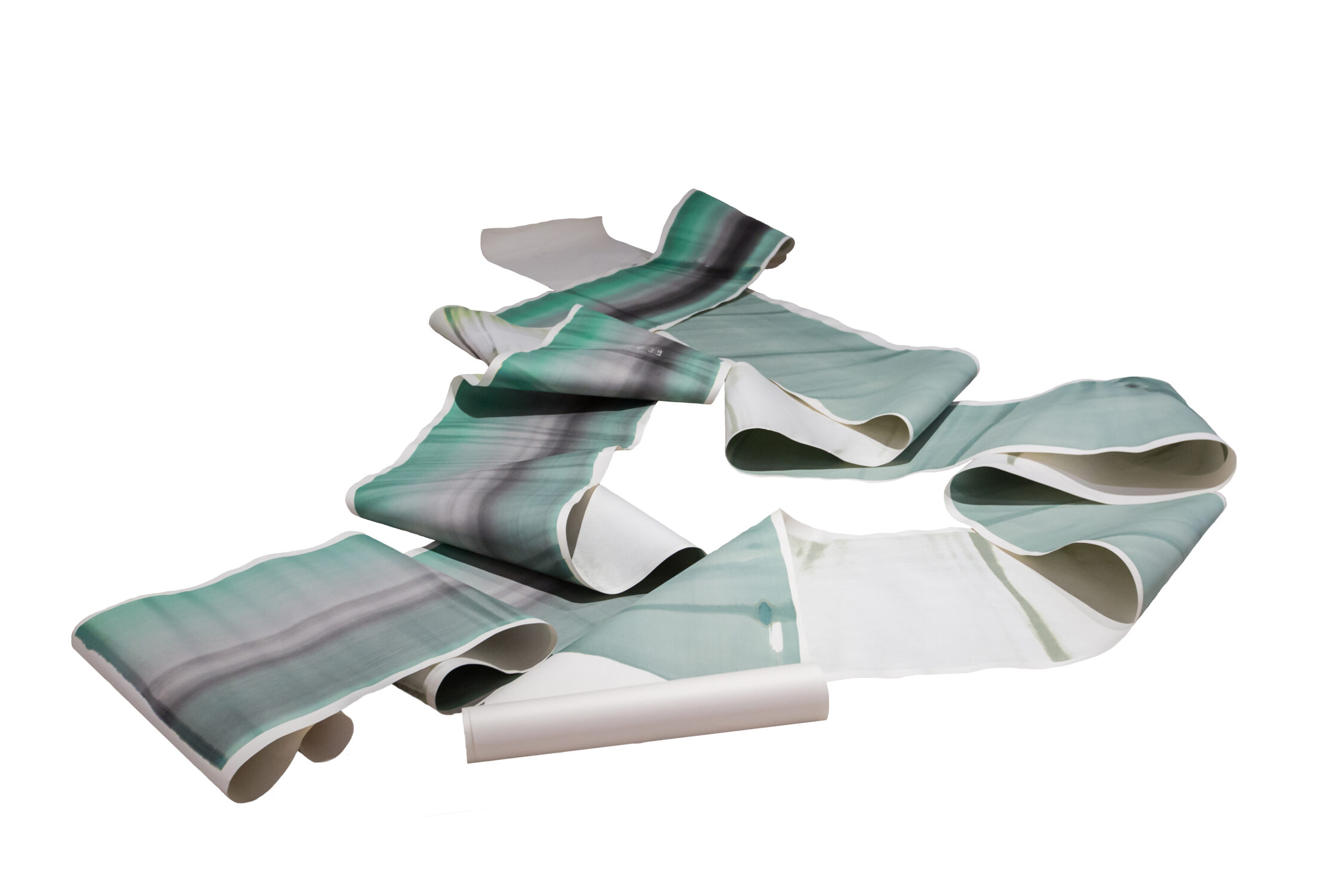
Kinga Popiela (born 1991, Kalisz)
She lives and works in Poznań.
She obtained her master’s degree at the Faculty of Painting of the Magdalena Abakanowicz University of Fine Arts in Poznań in the studio of prof. Dominik Lejman and prof. Andrzej Pepłoński. In 2022, she defended her doctoral thesis entitled: POSTPICTOR: Ciało narzędziem [Eng. POSTPICTOR: Body as a tool]
Her field of interest is divided into two areas. The first is the creative and visual part: paintings and works on paper, which provide a space for thinking about gesture, color, the scale of the image and its impact on the viewer. She works mainly in the area of geometric abstraction, which she combines with body expression. The second part of her interests is an attempt to observe and analyze the creative process and all issues accompanying it: the impact of the surrounding world on the individual, the potential to deepen the creative process and the possibility of expanding manual skills through physical exercises and the development of self-awareness. She publishes her progress in this area in the form of texts and scholarly works.
Winner of the Mayor of Kalisz Award in the Field of Culture in the Visual Arts category, Kalisz, 2021; Winner of the 27th Young Painting Review PROMOCJE (Legnica 2017) and the Art&Fashion Forum Powered by Grażyna Kulczyk Festival (Poznań, 2014). Honored in the 13th Geppert Competition (Wrocław, 2020).
She displayed her works at collective and individual exhibitions in Poland and abroad, in galleries including: Galeria Bielska BWA, Wozownia Art Gallery in Toruń, The Stefan Gierowski Foundation in Warsaw, Wizytująca Galeria in Warsaw, BWA Wrocław Główny Gallery, Jan Tarasin Art Gallery in Kalisz, or Galeria Labirynt in Lublin.
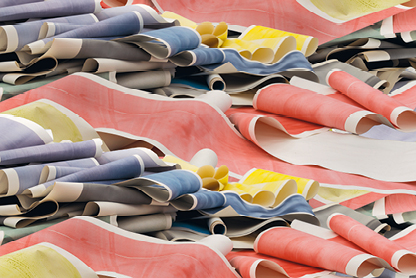
Exhibition duration Feb 9 – Mar 8 2024
Opening Feb 9, 7 P.M.
Meet the author session: 8 P.M.
Free admission
CULTURE INSTITUTION OF KALISZ
pl. św. Józefa 5
62-800 Kalisz Poland
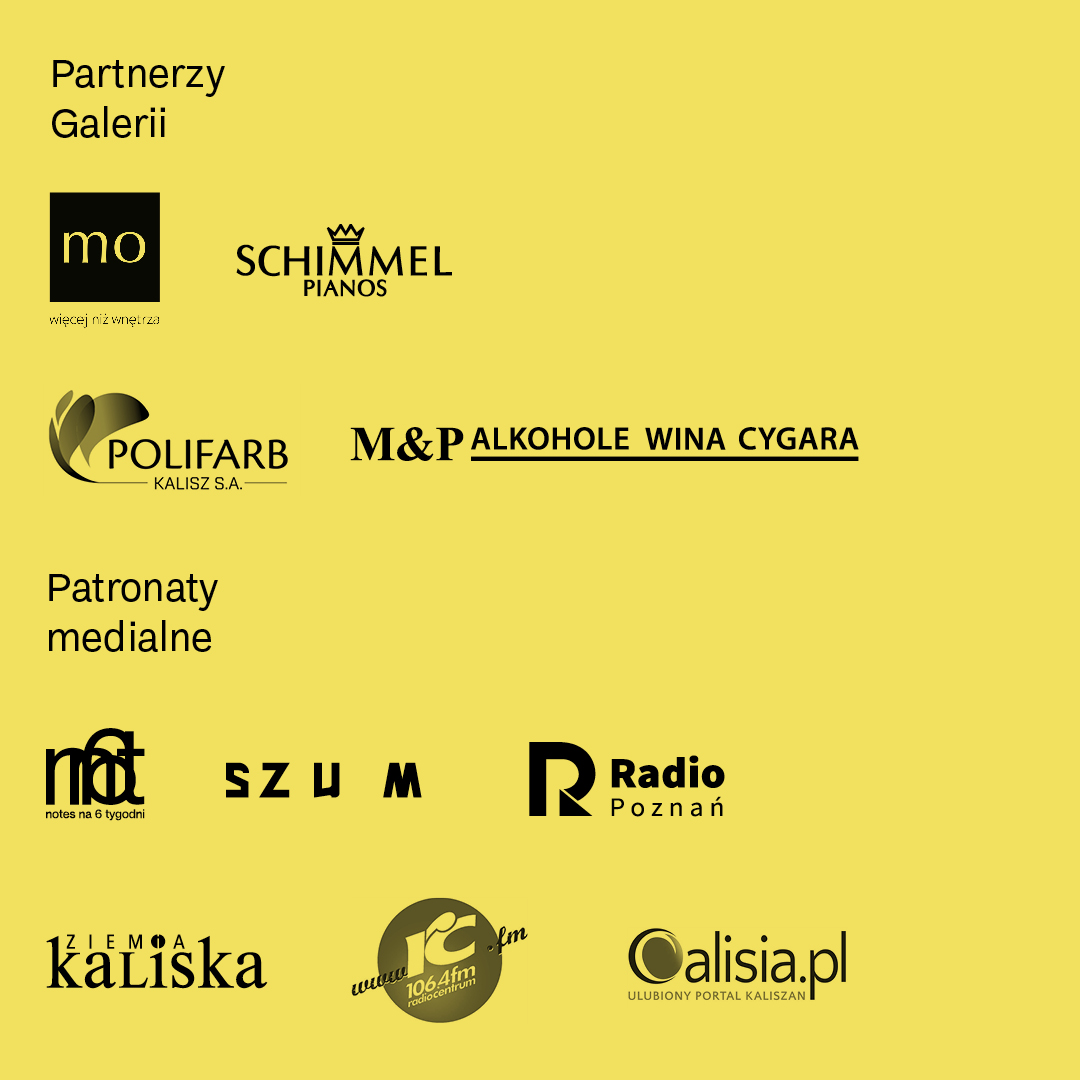
Gallery Partners:
ERGO HESTIA, POLIFARB KALISZ S.A., M&P Alkohole Wina Cygara
Media patronage:
NN6T, MAGAZYN SZUM, RADIO POZNAŃ, RADIO CENTRUM, CALISIA.PL, ZIEMIA KALISKA.








